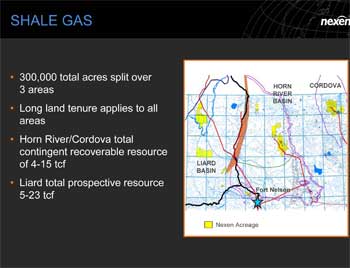A $5.4 billion deal between Canadian exploration giant Encana, one of the partners in the KM LNG project, and PetroChina collapsed Tuesday, sending shocks through both the financial markets and the energy exploration and production sector.
International analysts are already saying that China may be pulling back in its strategy to get a foothold in key resource areas and perhaps the Canadian energy sector was too optimistic. Perhaps.
If the analysts are correct, that means that some of the grand plans to export natural gas, at least to China, may still go ahead, but won’t immediately turn British Columbia back into the fabled Golden Mountain that brought the labourers from China more than a century ago to build the railways. Nor does this mean a major threat, at this point, to plans to export gas through Kitimat as there are plenty of buyers in Japan, Taiwan, South Korea and Malaysia looking at northeast BC shale gas.
The Wall Street Journal Heard on the Street blog says
E&P executives across North America should also be nervous. While some speculate Canadian-resource nationalism has spread from potash to energy, there is little evidence of this, given other similar deals haven’t been blocked. The alternative explanation is that foreign buyers of North American gas assets may actually care about such quaint notions as return on investment.
That isn’t good news for an E&P sector that consistently lives beyond its means.
Although China has gained a reputation for buying up resources around the world at any cost, a string of recent failed deals suggests the country’s resources companies are starting to drive harder bargains and are becoming more selective. In April, China’s Minmetals withdrew a $6.5bn offer for Equinox, an Australian-Canadian copper miner, rather than raise its bid after a higher offer emerged from Barrick Gold.
Chinese oil companies have also recently walked away from, or missed out on, prized oil and gas assets in Brazil …
The failure of the Encana-PetroChina deal is a surprise to the industry because Chinese companies have recently been investing aggressively in shale gas assets to gain the expertise needed to develop China’s own reserves.
Reuters reported from Edmonton that it was Encana who walked away from the deal:
Encana, Canada’s No. 1 natural gas producer, said the two companies could not find common ground, despite a year of negotiations, and walked away from a deal that would have seen PetroChina take a one-half stake in Encana’s massive Cutbank Ridge field in northern British Columbia.
“We just reached the point where we determined we just couldn’t go forward” said Alan Boras, a spokesman for Encana.
The deal would have been the largest in a string of investments by Asian companies in North America’s prolific shale gas discoveries, while Encana investors were counting on the cash to shore up a balance sheet battered by more than two years of weak natural gas prices…
The CBC report had analysts disagreeing on Encana’s role:
John Stephenson, portfolio manager with First Asset Investment Management in Toronto, called the scuttled deal “a complete and utter failure.”
“I think they just couldn’t agree on anything and I think they were premature maybe in announcing this before they had an operating agreement in place,” he said….
But Lanny Pendill, an energy analyst with Edward Jones in St. Louis, commended Encana for its discipline….Its willingness to walk away from a deal after a year of work shows “if push comes to shove, they’re going to make the decision that’s in the best interest of Encana and Encana shareholders.
The Globe and Mail says Encana has plenty of assets in shale gas, especially the Horn River developments which were often mentioned as the main source for shale based natural gas that could be shipped through Kitimat:
With the PetroChina joint venture out of the picture, Encana still has lots of potential. For starters, back in April, the company said it was looking to start discussions on joint venture proposals for its Horn River and Greater Sierra assets. On the heels of Tuesday’s announcement, Encana said that the prospects for these projects are looking up, and raised its 2011 expected proceeds from them to between $1-billion and $2-billion, up from $500-million and $1-billion
Encana news release (on Encana site)
Encana news release 0621-petrochina-jv-negoiations-end.pdf


 interviews Enbridge’s Pat Daniels
interviews Enbridge’s Pat Daniels
